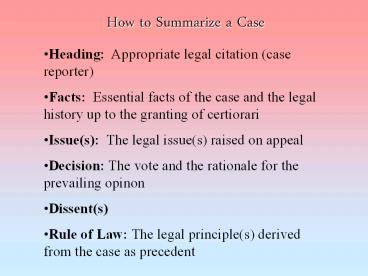How to Summarize a Case - PowerPoint PPT Presentation
1 / 6
Title:
How to Summarize a Case
Description:
Facts: Essential facts of the case and the legal history up to the granting of certiorari ... New York Times v. United States, 403 U.S. 713 (1971) ... – PowerPoint PPT presentation
Number of Views:48
Avg rating:3.0/5.0
Title: How to Summarize a Case
1
How to Summarize a Case
- Heading Appropriate legal citation (case
reporter) - Facts Essential facts of the case and the legal
history up to the granting of certiorari - Issue(s) The legal issue(s) raised on appeal
- Decision The vote and the rationale for the
prevailing opinon - Dissent(s)
- Rule of Law The legal principle(s) derived from
the case as precedent
2
Freedom of Speech and Freedom of the
Press Sedition and Censorship
3
Sedition
Sedition Act of 1918 upheld in a number of
decisions, including Schenck and Abrams, but
lapses in 1920s Smith Act of 1940 advocate,
abet, advise, or teach the duty , necessity,
desirability, or propriety of overthrowing or
destroying the government of the United
States upheld, in principle, in Yates v. United
States (1957), but the speech must urge someone
to commit illegal acts
4
Sedition
The States Unconstitutional Ashton v. Kentucky
(1967) Government officials cannot use sedition
laws to curb public criticism Brandenburg v.
Ohio (1969) defines difference between
advocacy and incitement
5
Prior Restraint
CENSORSHIP!
6
Prior Restraint
- Near v. Minnesota,
238 U.S. 697 (1931) - New York Times v. United States, 403 U.S. 713
(1971) - United States v. The Progressive, 467 F. Supp.
990 (W.D.Wis. 1979) - Hazelwood S.D. v. Kuhlmeier,
484 U.S. 260 (1988)































